BIODIVERSITY CONSERVATION IN CUBA
Results
|
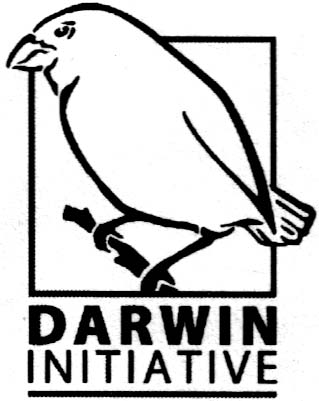
|
Acquisition, transport and delivery of donated equipment
Awards and prizes
Computerization of data about neglected groups of organisms
Courses for parataxonomists
Fieldwork at specific locations
Greater presence for Cuban biodiversity science and conservation on the internet
Nature reserve management plan workshops
New Darwin Building at La Sabina
Participation in international scientific meetings
Production of nature reserve management plans
Publications produced through the project
Training
Work to establish a regional identification service for fungi
AWARDS
Collaboration through the present Darwin Initiative project, and the preceding Darwin Initiative project Fungi of the Caribbean has been recognised through two prizes and awards.
|
The prize of the University of La Habana for the best scientific book published in 2002 was awarded to: Minter, D.W.; Rodríguez Hernández, M.; Mena Portales, J. (2001). Fungi of the Caribbean, an Annotated Checklist. 946 pp., UK, London, Isleworth; PDMS Publishing. ISBN 0 9540169 0 4. |
|
The 2003 prize of the Academy of Sciences of Cuba was awarded for work on Diversity and Conservation of fungi of the Caribbean. |
NATURE RESERVE MANAGEMENT PLAN WORKSHOPS
During the life of this project, a series of workshops on preparation of protected area managment plans were held in different locations throughout Cuba. Most participants were staff of different protected areas administered by the Empresa Nacional para la Protección de la Flora y la Fauna. The first, held at the Jardín Botánico Nacional, Havana, in November 2001 was led by Alan Bennell, Director of External Relations, Edinburgh Botanic Garden, with nine participants. Subsequent workshops, in April 2002, June 2002 and other dates, in Holguin and other locations, were organized directly by the Empresa with Darwin Initiative support.
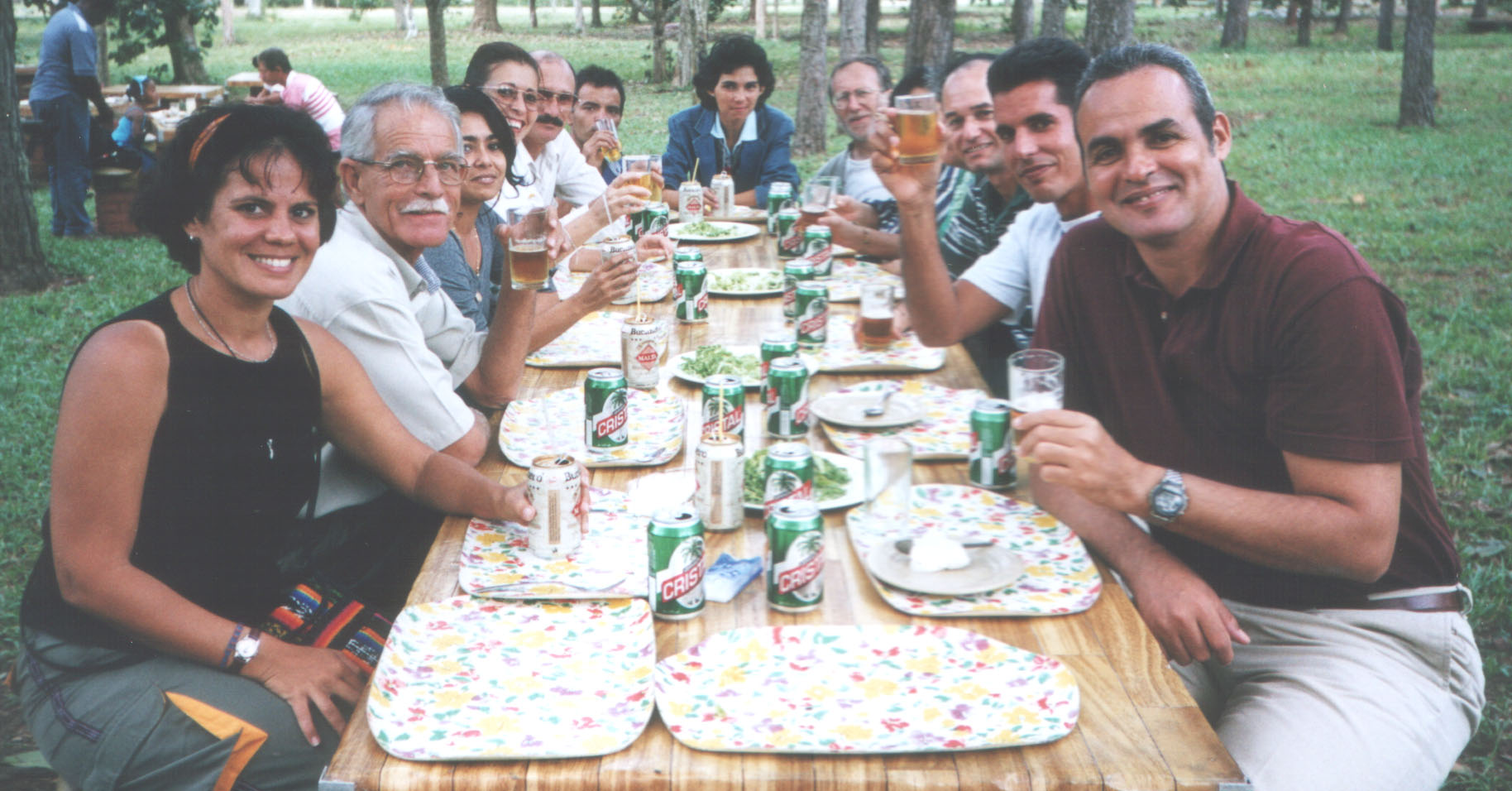
A communal lunch for some participants of the first workshop at the Jardín Botánico Nacional, November 2001
One of those workshops, described here as an example, was run in February 2003 at Alturas de Banao, about 300 km east of Havana, and was led by Jose Miguel Rodríguez, Assistant Director of the Empresa.
|
|
About 12 members of staff of the protected area, including the local schoolteacher, participated.
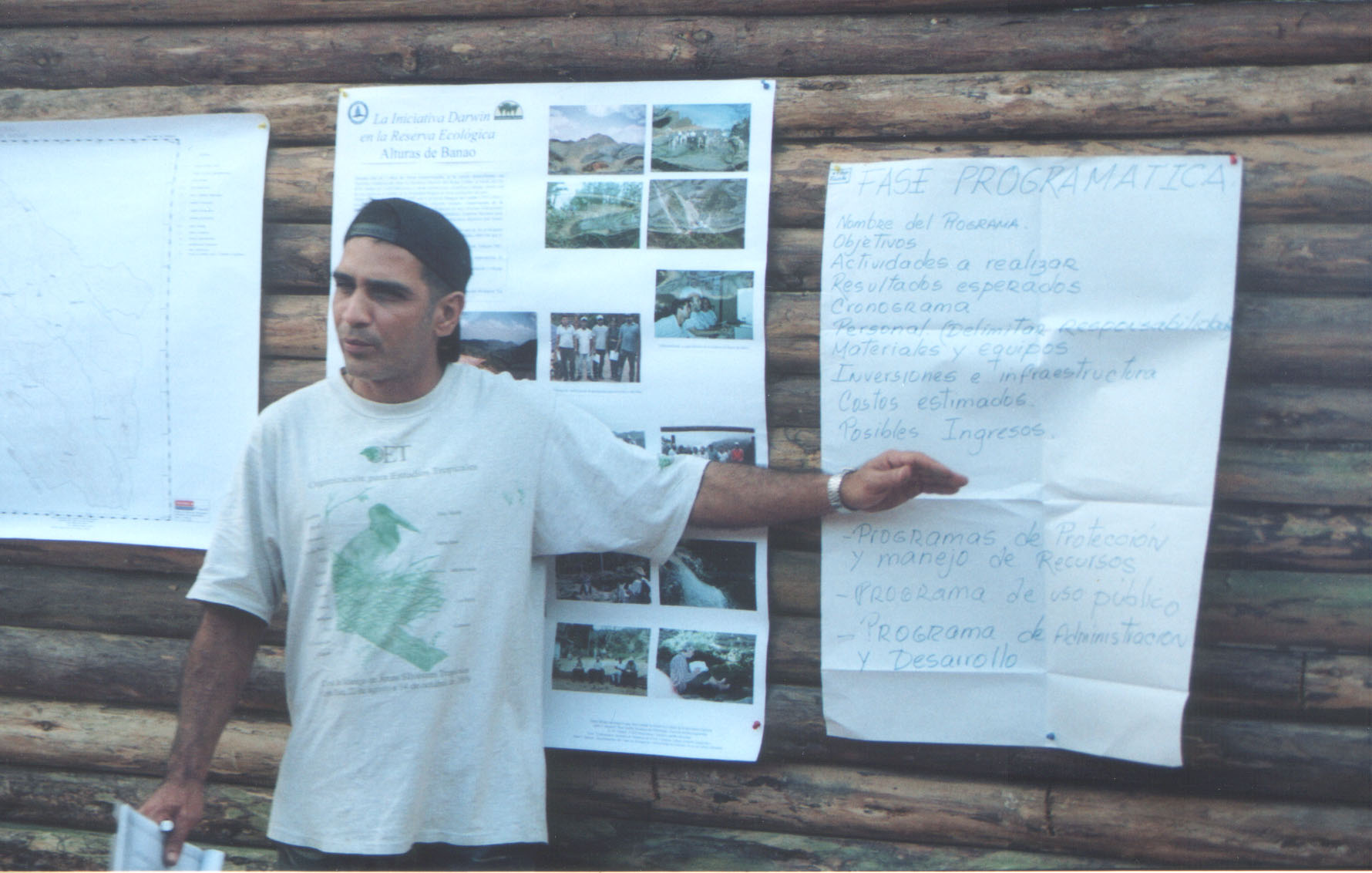
José-Manuel Rodríguez Vásquez leads a workshop in the then unfinished new Darwin Building at Alturas de Banao
The workshop took participants through each main planning stage, including such basics as SWOT analysis (Strengths Weaknesses Opportunities Threats), known in Spanish as DAFO (Debilidades Amenazas Fortalezas Oportunidades). Dave Minter, project leader, and Mayra Camino, one of the Cuban co-ordinators of the project were also present and assisted.
The workshop was held in the interesting surroundings of the half-completed new Darwin Building under construction at the reserve's La Sabina field station.
|
PRODUCTION OF NATURE RESERVE MANAGEMENT PLANS
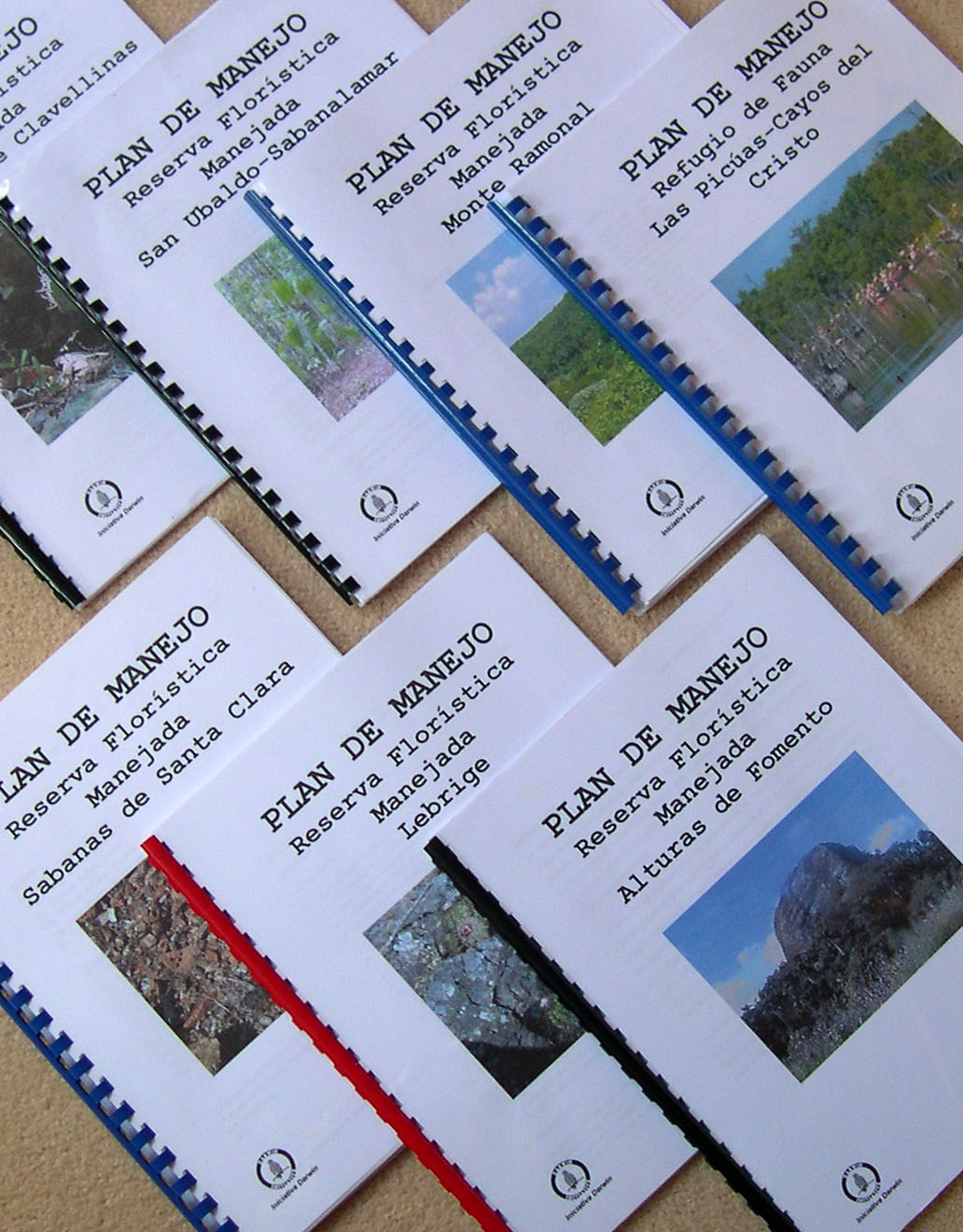
| |
Nature Reserve management plans were produced by Empresa Nacional para Protección de la Flora y la Fauna, using Darwin Initiative support for twenty-four reserves, national parks and other protected areas.
Each plan follows, more or less, a set pattern, with an introduction, then three main parts: an assessment of the present position, a review of objectives together with an analysis of strengths and weaknesses and, finally, a series of plans designed to take the reserve in question from its present position to the desired condition stated through the objectives. Almost all plans also have a bibliography and annexes providing lists of plants and animals (but not other organisms) of the reserve, and maps. Some are also provided with illustrations of the scenery of the reserve, or of important plants or animals.
Some of the management plans produced during the current project
|
WORK TO ESTABLISH A REGIONAL IDENTIFICATION SERVICE FOR FUNGI
One of the objectives of this project was to put in place a regional identification service for fungi in the Caribbean. This has not yet been achieved, mainly because of a highly unfavourable world political climate after the bombing of New York in September 2001 and subsequent anthrax and ricin terrorist threats.
Solid progress towards an identification service has however been made. Much of the infrastructural work described elsewhere on this web-page has contributed to this. Mycologists in Cuba now have much improved computing and literature resources, together with additional light and electron microscopes and cameras. They also have the huge informational resources of a database of over 160000 records of fungi from the Caribbean and electronic distribution maps of each species. In addition, improvements have been made to their laboratories, and facilities for handling pure cultures have been improved with the donation of freeze-drying equipment.
Concerns about biosafety mean that, at least initially, the hoped-for identification service would deal only with identification of dried preserved reference specimens, perhaps received by a secure and reputable scientific agent abroad then forwarded to Cuba for examination. Possibilities in this direction are currently being explored.
ACQUISITION, TRANSPORT AND DELIVERY OF DONATED EQUIPMENT
Over the life of this project, over 2 tons of equipment was acquired from various donors, checked, packed, transported and delivered to Cuba to be used for conservation of the island's biodiversity.
The first tranche, 45 desktop computers, was delivered to users in Cuba by the end of June 2001. Two scanners and various printers were also delivered by November 2001. Purchase of a few new computers in Cuba and ten laptops (May 2002) took the total of donated computers to nearly sixty by December 2002.
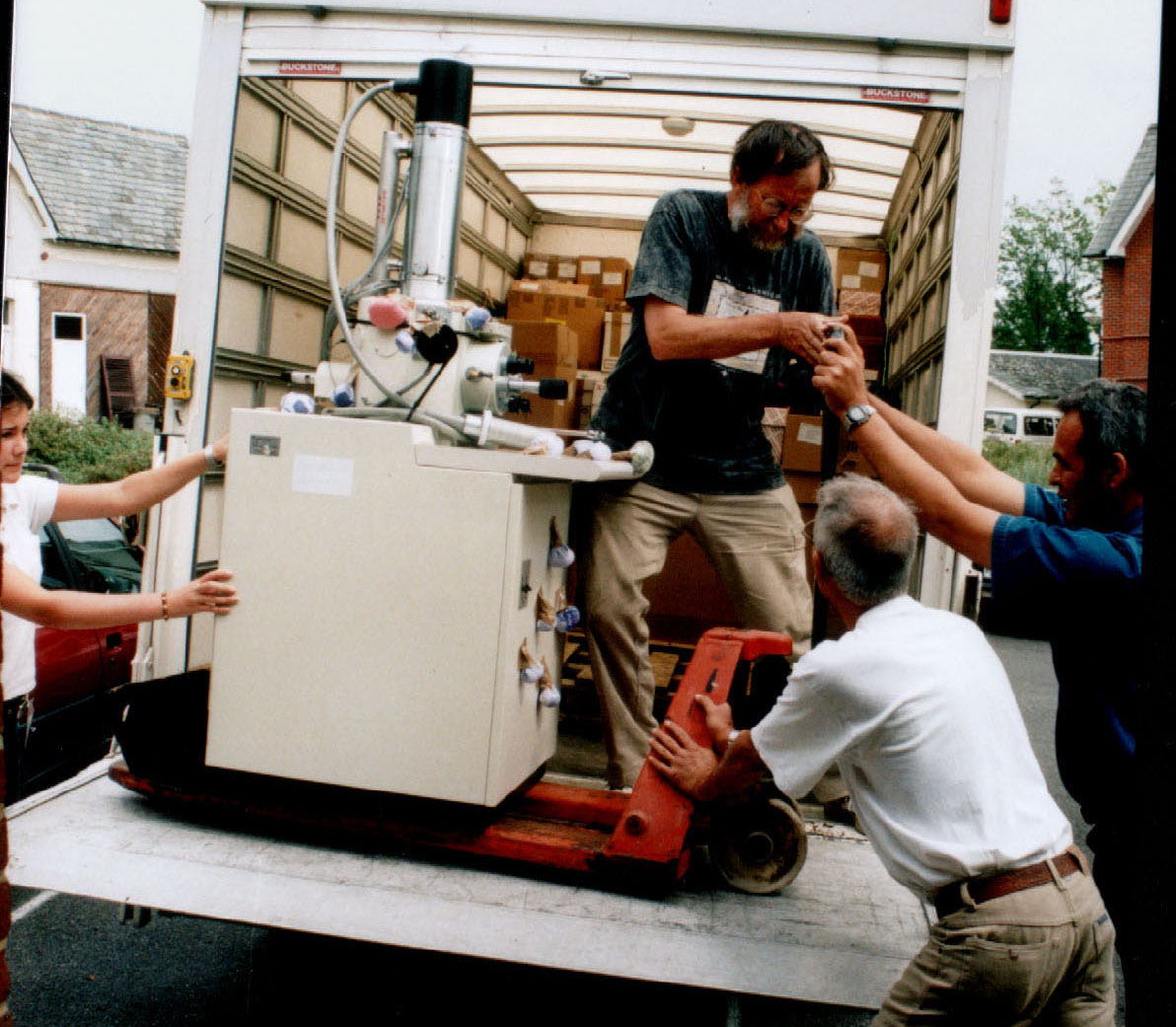
Easy does it: Katherine Copeland, Dave Minter, Miguel Rodríguez Hernández and Julio Mena Portales manoeuvre part of the electron microscope on a truck tail-lift
In March 2002, a fully working scanning electron microscope was offered by CABI Bioscience to Cuba through this project, and an offer of a freeze drier from Aberdeen University followed in May 2002. These were collected, decommissioned for the journey and packed during August 2002, along with sixty-five boxes containing accessories for the electron microscope (a cryo unit, two sputter coaters, a cooling system, pumps etc.), further desktop computers, printers, scanners, several compound microscopes, several dissecting microscopes, and analogue cameras.
Also in those boxes were 12 cartons of printing paper, pens and other stationery for environmental education of children at nature reserves, together with long runs of scientific journals, notably Transactions of the British Mycological Society, Mycological Research, the Botanical Journal of the Linnean Society, Taxon, the Lichenologist, Mycologia and Taxon. This consignment was delivered in several journeys to a container in Tilbury organized by ASLEF (the UK railways trade union) to send aid to Cuba, and to a warehouse in Manchester storing ambulances and fire-engines for Cuba.
|
|
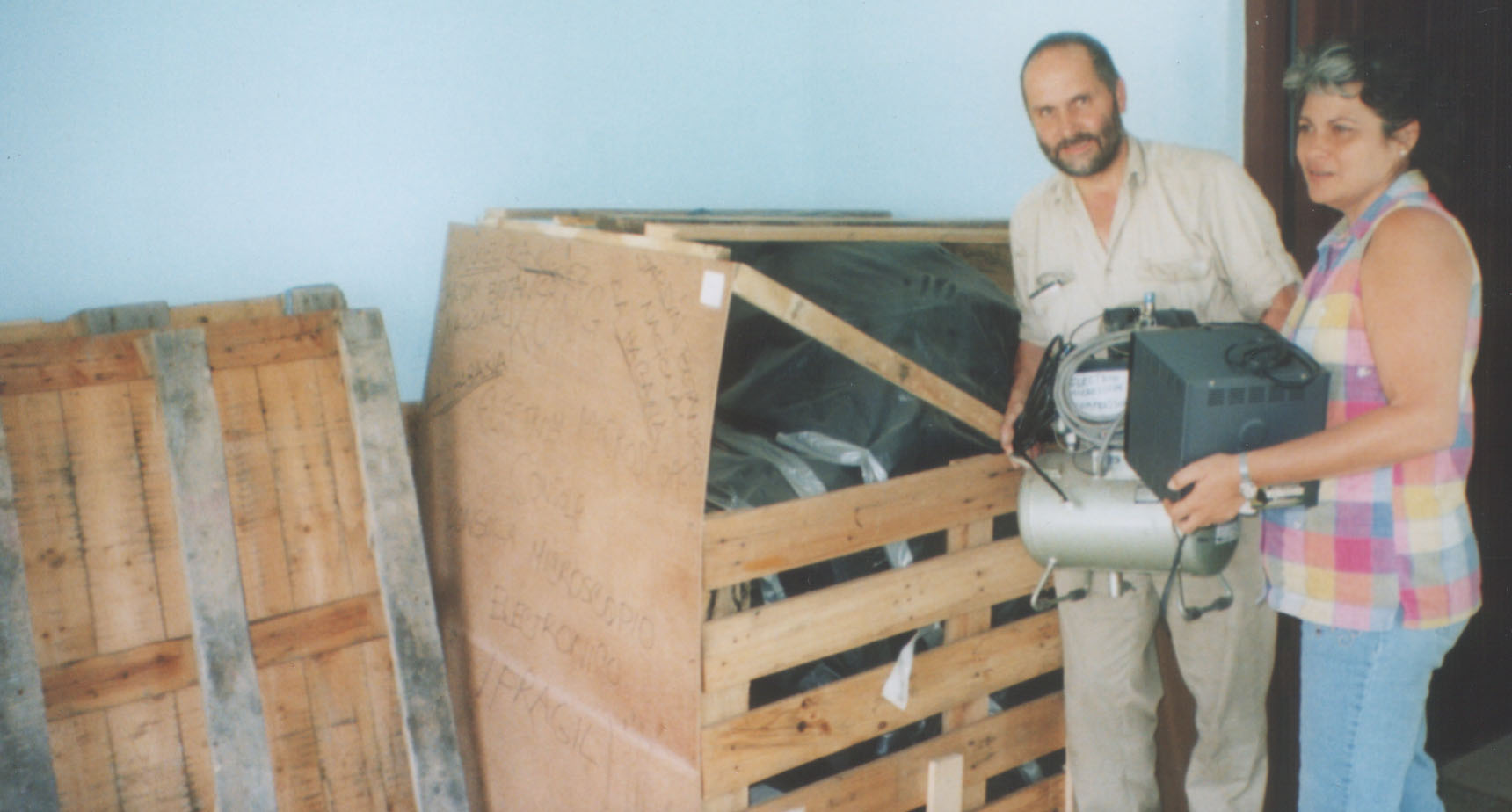
Alan Bennell (Royal Botanic Garden, Edinburgh) and Mayra Camino (Jardín Botánico Nacional, La Havana)
unpack the electron microscope console in Havana
The electron microscope / freeze drier shipment, together with the accompanying sixty-five boxes arrived in Cuba in summer 2003, and equipment was delivered in October 2003. Meanwhile, further Digital cameras, desktop and laptop computers, printers and scanners were delivered. By the end of the project, the number of computers delivered for use in conserving Cuban biodiversity, including those organized during the earlier project Fungi of the Caribbean had topped 100.
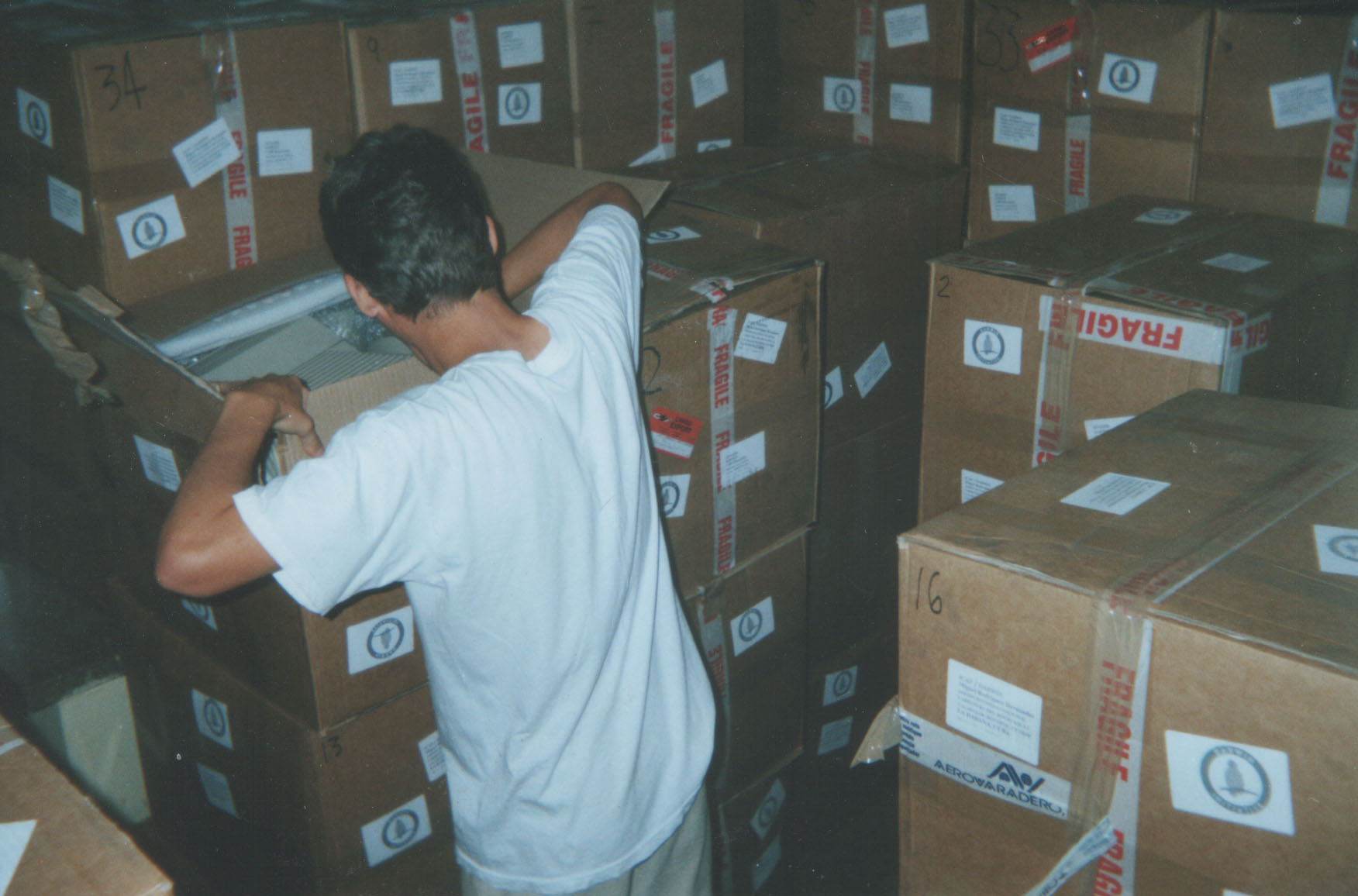
The boxes arrive: opening one of the packs containing desktop computers at the Jardín Botánico Nacional in Havana
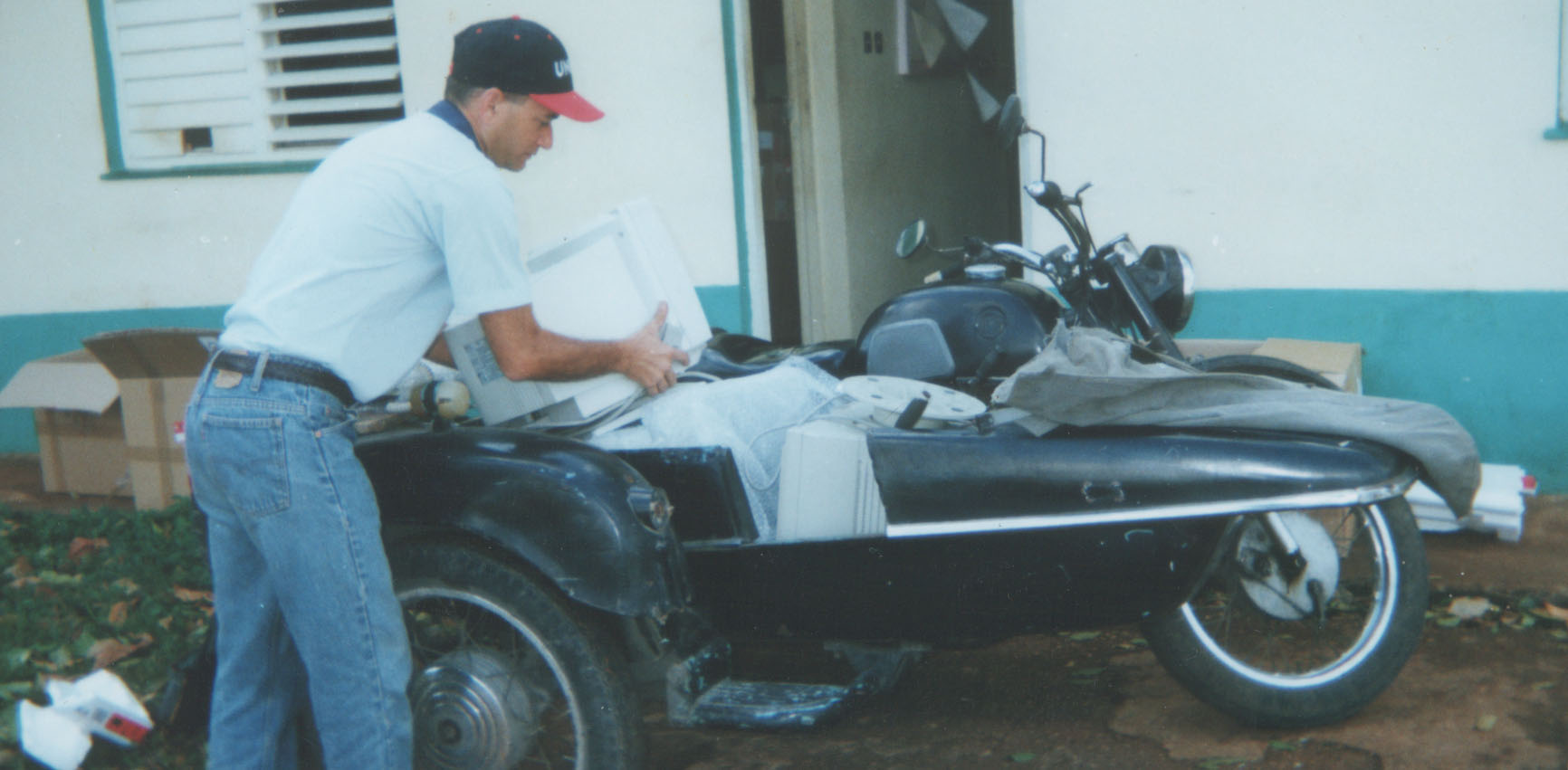
A full load: Hugo Iglesias Brito puts a third monitor on top of two others in the sidecar of the Darwin motorbike in Havana
In addition, the project was able to support Cuban biodiversity institutions with further equipment purchased in Cuba, including a freezer for the Herbarium at the Jardín Botánico Nacional, and furnishings and lighting for Alturas de Banao |
GREATER PRESENCE FOR CUBAN BIODIVERSITY SCIENCE AND CONSERVATION ON THE INTERNET
Prototype websites have been produced, using Darwin Initiative support, to provide basic information about the Empresa Nacional para Protección de la Flora y la Fauna, and for twenty-six of its reserves, national parks and other protected areas. For the INIFAT Culture Collection, for the Viñales National Park and for 14 Cuban biodiversity specialists (most as both English and Spanish versions). An illustrated guide to the plants of Viñales has also been produced and made available on the internet, with descriptions, keys, photographs of leaves, flowers and, where appropriate, bark, and indexes of scientific and common names of over 150 species including many rare endemics. These websites can all be accessed from hyperlinks within this project's website. In addition, the major website Electronic Distribution Maps of Caribbean Fungi, with over 11,000 maps, and with ancillary pages in both English and Spanish, was produced during the life of this project.
PARTICIPATION IN SCIENTIFIC MEETINGS
Darwin Initiative support for Cuban scientists working with biodiversity through this project enabled a remarkable amount of involvement for them in scientific meetings. This was particularly appreciated, given the difficulties and isolation they so often experience. Some of the main events are listed below.
Second International Symposium on Information Technology in Biodiversity Research, St Petersburg (May 2001) [http://www.bionet-intl.org/html/whatsnew/updates/StPb2001.htm]
Attended by Julio Mena Portales, who presented a paper entitled The software "CLAVES" and its applications: computerized keys for identification of plant pathogenic fungi in Cuba. David Minter, as one of the main organizers of the event, was also scheduled to attend, but prevented from doing so by health problems.
IV Congreso Latinoamericano de Micología, Xalapa, Mexico (May 2002)
This was a particularly important event, given that Cuba organized both the first and the second congress in this series, and (thanks to the previous Darwin Initiative project, Fungi of the Caribbean) had a big presence at the third congress in Caracas in 1999. Six mycologists from Cuba attended the IV Congreso in 2002 with support from the present project (Rafael Castañeda Ruíz, Sara Herrera Figueroa, Julio Mena Portales, Ángel Mercado Sierra, José-Manuel Pérez Hernández & Miguel Rodríguez Hernández), and were able to present not only their own work, but also the research of three other Cuban colleagues (Mayra Camino Vilaró, Susana Maldonado González & Gloria Recio Herrera). One of the Cuban co-ordinators of the present project, Miguel Rodríguez Hernández, as President of the first two congresses of the series, was honoured with the freedom of Xalapa. Works presented at the Congress included:
|
El género Neohypodiscus (Ascomycota) en Cuba |
|
Revisión del género Kretschmaria (Ascomycota) en Cuba |
|
Nuevos registros de la familia Stemonitaceae (Myxomycetes) para Cuba: Lamproderma scintillans y Stemonitis smithii |
|
Siglo y medio de Micología en el Caribe. Avances y retos. [Keynote Address] |
|
Base de datos de los Hongos del Caribe: El Proyecto Darwin |
|
Características naturales de Cuba que permiten un alto grado de diversidad fúngica |
|
El género Sporisorium en Cuba: estado actual de su conocimiento |
BioNET-INTERNATIONAL Third Global Taxonomy Workshop, Pretoria, South Africa (July 2002) [http://www.bionet-intl.org/3gtw/index.htm]
Attended by Julio Mena Portales, one of this project's Cuban co-ordinators. Support from the Darwin Initiative meant that Dr Mena Portales was able to participate in this important workshop, taking Cuba a step closer to joining BioNET-INTERNATIONAL and CARINET, its LOOP in the Caribbean. Dr Mena Portales presented a paper entitled State of knowledge of fungi in the Caribbean region.
7th International Mycological Congress, Oslo, Norway (August 2002)
The world's biggest mycological event. Darwin Initiative support enabled Cuban project co-ordinators Julio Mena Portales and Miguel Rodríguez Hernández to attend, travelling from the UK jointly with project leader David Minter and Tetiana Andrianova (Ukraine), participant in another Darwin Initiative project. David Minter chaired a session on computerized databases on the internet, while Julio Mena Portales, Miguel Rodríguez Hernández and Tetiana Andrianova all presented invited papers. The main Cuban presentations were:
|
Foliicolous Diversity: The Caribbean example |
|
Capturing mycological data, the Caribbean experience |
4th International Congress on Systematics & Ecology of Myxomycetes, Brussels, Belgium (August 2002)
The world's main myxomycete meeting. Attended by Cuban project co-ordinator Mayra Camino Vilaró (together with Tetiana Kryvomaz, participant of another Darwin Initiative project in Ukraine). Dr Camino presented two papers:
|
Biodiversity of myxomycetes in the Ecological Reserve “Alturas de Banao”, Sancti Spíritus, Cuba |
|
The family Stemonitaceae in Cuba: current state of studies |
International Workshop on Myxomycetes, Havana & Alturas de Banao, Cuba (November 2002) [http://msafungi.org/54(1).pdf]
Led by Mayra Camino Vilaró and organized through this Darwin Initiative project, with fieldwork in Alturas de Banao, with participants from Cuba, Mexico, Spain, the UK, Ukraine (tropical experience for Tatiana Kryvomaz, participant of aDarwin Initiative project in Ukraine) and the USA.
IV Convención Internacional sobre Medio Ambiente y Desarollo, Havana, Cuba (June 2003)
Cuba's national strategy for conservation of fungal biodiversity, Estrategia para la Conservación de Biodiversidad Fúngica en Cuba, produced through the Darwin Initiative project Fungi of the Caribbean and refined in the present project, was presented under the joint authorship of Julio(Mena Portales, Sara Herrera Figueroa, Ángel Mercado Sierra, David Minter, Hugo Iglesias Brito, Nelis Blanco Hernández, Jorge Ortiz Medina, Susana Maldonado González, Gloria Recio Herrera, Miguel Rodríguez Hernández & Mayra Camino Vilaró.
COURSES FOR PARATAXONOMISTS
An additional output from this project, not originally scheduled, was the organization of courses for parataxonomists. These were held at four locations, as follows:
|
Alturas de Banao (November, 2002). A five-day course, led by scientists from the Jardín Botánico Nacional, with 9 students from 3 protected areas (approximately 300 specimens - 62 of them fungal - were collected during this course). |
|
Mil Cumbres (October, 2003). A five-day course, led by scientists from the Jardín Botánico Nacional and the Instituto de Ecología y Sistemática, with 8 students from 2 protected areas. |
|
Ciénaga de Zapata Biosphere Reserve (May, 2003, May). A three-day course, combined with an expedition, with 5 local staff and 6 scientists from the the Instituto de Ecología y Sistemática. |
|
Cuchillas del Toa Biosphere Reserve (September, 2003). A course, combined with an expedition, also partly funded through the Université Catholique de Louvaine with 7 local staff and scientists from the Instituto de Ecología y Sistemática. |
FIELDWORK AT SPECIFIC LOCATIONS
During the three years of this project, fieldwork was carried out at three main sites, and several other locations. The main objective was basic surveying work for fungi, including myxomycetes (Protozoa) and downy mildews (Chromista), but it was also possible sometimes to support sampling work by scientists interested in other groups, notably botanists working through the Royal Botanic Garden of Edinburgh on its International Conifer Conservation Programme.
Right. Alan Bennell and Martin Gardner (RBG Edinburgh) make notes on specimens recently collected and pressed at Alturas de Banao |
|
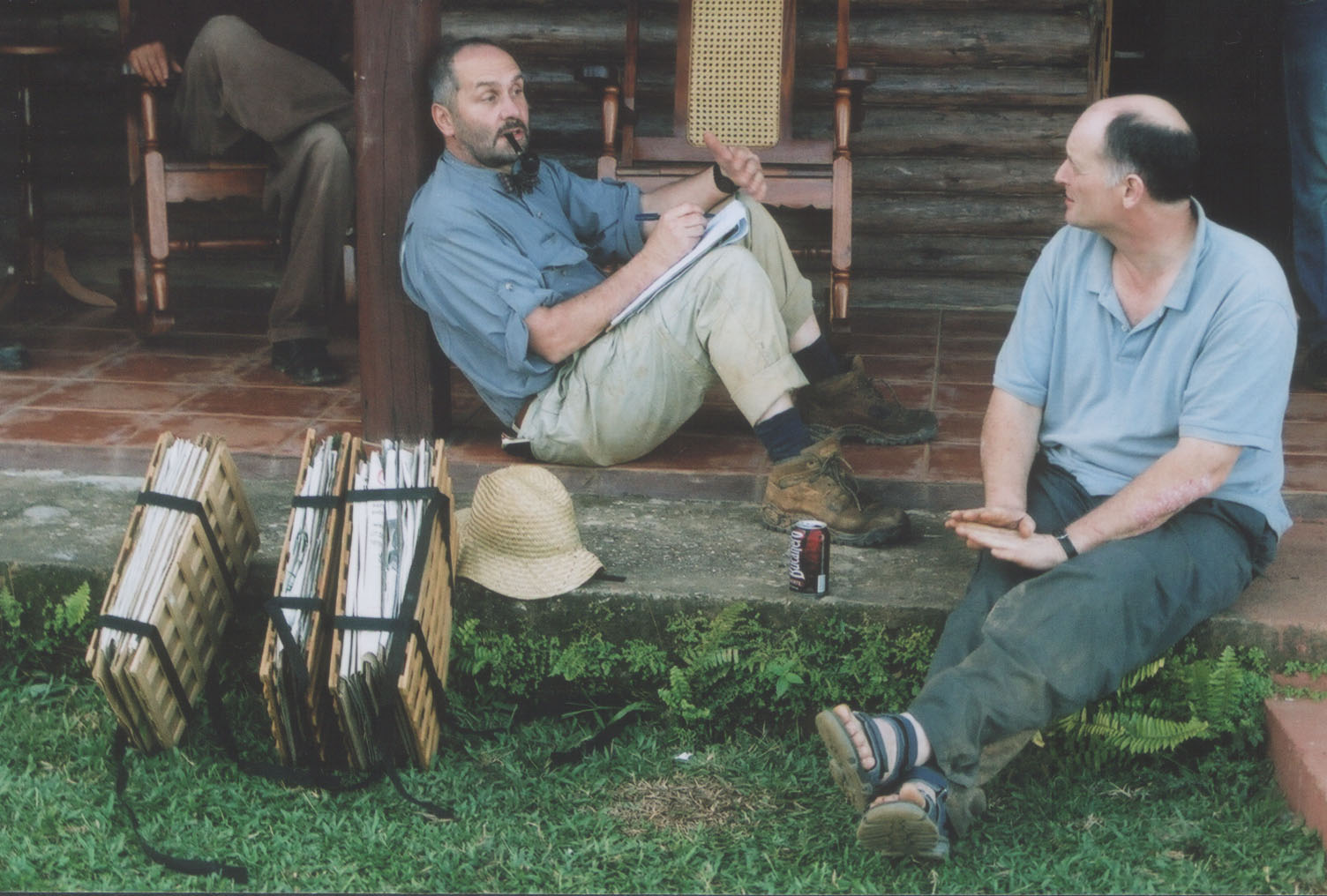
|
|
Alturas de Banao. Specimens of fungi, myxomycetes and downy mildews were collected as follows. November 2001 (135); November 2002 (62); February 2003 (27); August 2003 (28); November 2003 (93); January 2004 (232). Total: 577 specimens, of which 48 isolates were made into pure culture by Rafael Castañeda Ruíz. During the November 2003 expedition, Dr Martin Gardner (RBG Edinburgh was able to collect specimens for the garden's International Conifer Conservation Programme |
|
Ciénaga de Zapata Biosphere Reserve. Field work was carried out through two expeditions in 2002 and one in 2003 carried out by mycologists at the Instituto de Ecología y Sistemática, Havana. Statistics for numbers of collections are not yet available. |
|
Cuchillas del Toa Biosphere Reserve. Field work was carried out through two expeditions, one in 2002 and one in 2003 carried out by mycologists at the Instituto de Ecología y Sistemática, Havana, partly funded through the Université Catholique de Louvaine. Statistics for numbers of collections are not yet available. |
|
Parque Nacional Viñales. A series of field trips were made to collect fungi, and to photograph plants of this national park, as follows. November 2001; January and September 2002; April, September and December 2003; March 2004. Total: 249 fungal specimens collected. |
|
Parque Nacional Pico Turquino. A single expedition visited this national park in November 2003, resulting in a total of 161 fungal specimens collected. During this expedition, Dr Martin Gardner (RBG Edinburgh was able to collect specimens for the garden's International Conifer Conservation Programme |
|
Other. Various other small expeditions were organized through this project, including trips to Cienfuegos, Camagüey, Las Tunas, Pinar del Río, Holguín and Villa Clara to collect smut fungi, and trips to Cuba's south coast to collect marine microfungi. |
TRAINING
In addition to the workshops training staff of nature reserves and other protected areas in writing management plans, and in addition to workshops for parataxonomists, the present project also provided opportunities for two Cuban scientists to visit the UK to gain further experience in database techniques and production of websites (part of this travel was also provided by the British Council).
|
2001 September. Hugo Iglesias Brito visited the UK to work on mapping information for the publications on electronic distribution maps of Caribbean fungi. |
|
2002 August. Mayra Camino Vilaró visited the UK to work on mapping information for the publications on electronic distribution maps of Caribbean fungi. |
|
2003 March, Hugo Iglesias Brito visited the UK, using his training from Dr Kirk, to produce web pages for Caribbean mycology, but also with time to study reference collections of lichen-forming fungi in CABI Bioscience and the British Museum. |
|
2003 March. Mayra Camino Vilaró visited the UK to produce web pages for Caribbean mycology, but also with time to study reference collections of myxomycetes in CABI Bioscience, Kew and the British Museum. Dr Camino’s visit was synchronized so that she could go on for a further two months of separately-funded study with Prof. Gabriel Moreno at the Universidad de Alcalá de Henares in Spain, thereby maximizing benefits from several different projects. |
Dr Paul Kirk (CABI Bioscience) visited Cuba in November 2002, to provide training in design of mycological websites for Hugo Iglesias, one of the collaborators of this Darwin Initiative project (Dr Kirk’s visit was organized through this project, but funded from other sources).
THE NEW DARWIN BUILDING AT LA SABINA
The field station at La Sabina, Alturas de Banao, was used several times during the previous Darwin Initiative project, Fungi of the Caribbean. The old field station building there was constructed during Cuba's "special economic period", a time of many shortages. This meant the wood of the building was not properly protected. By early 2001, the structure had become so decrepit that demolition was necessary: the field station had, literally, been eaten. During the last visit to the field station under the earlier project, in February 2001, all that remained were the concrete floors, concrete walls of the bathrooms, the verandah posts and neat piles of tiles.
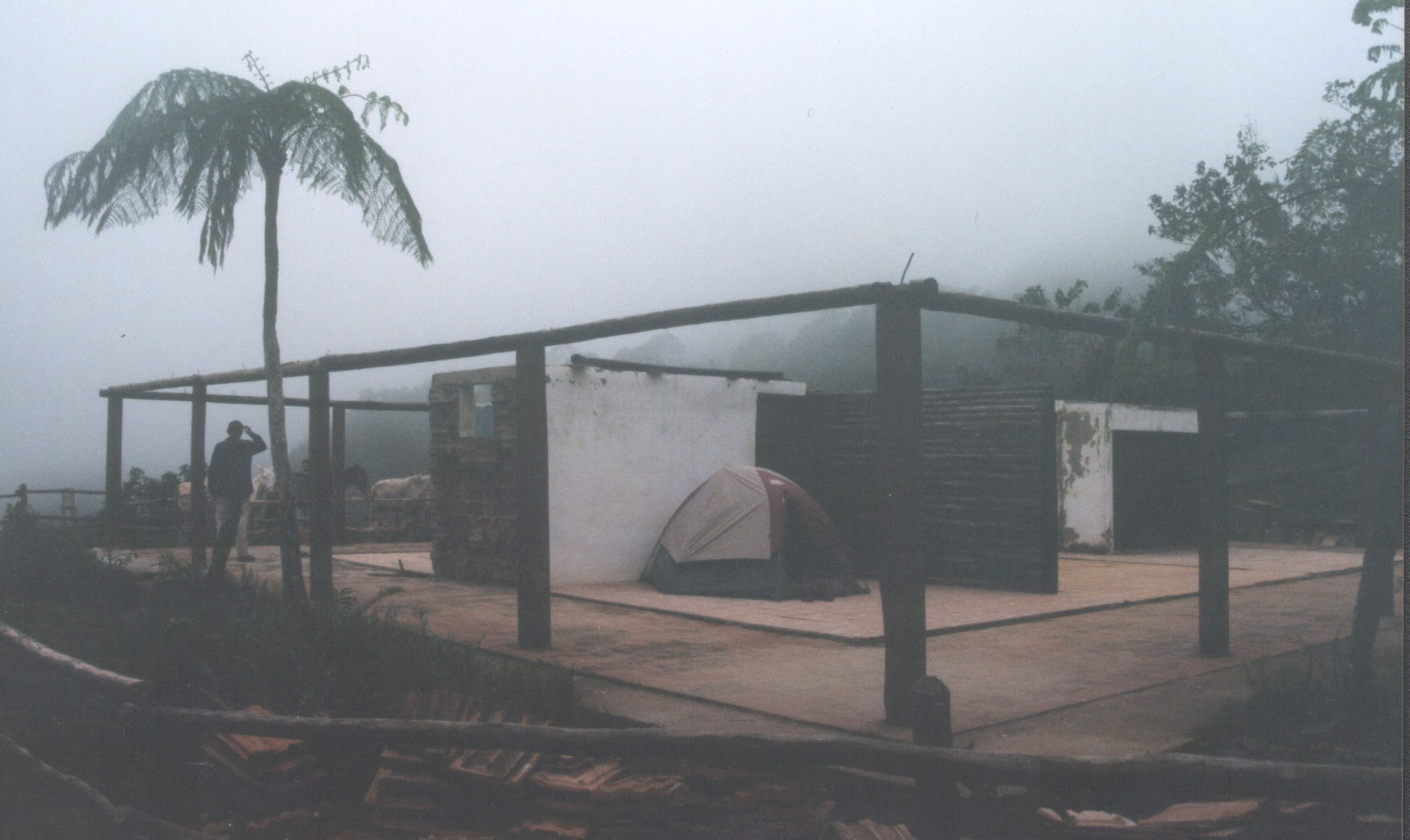
A wet early morning: camping in the destroyed remains of the old field station at La Sabina, Alturas de Banao
Although not originally planned as an output for the present project, the daring idea grew among participants that it might just be possible to replace this destroyed field station with a new "Darwin" building. Discussions were carried out at the highest level within the Empresa Nacional para la Protección de la Flora y la Fauna, and an agreement was reached in summer 2002 to share the costs of this ambitious work, the project paying for hard currency costs (roofing felt, cement, plumbing, nails, diesel and, particularly, wood preservative) and the Empresa bearing all other expenses.
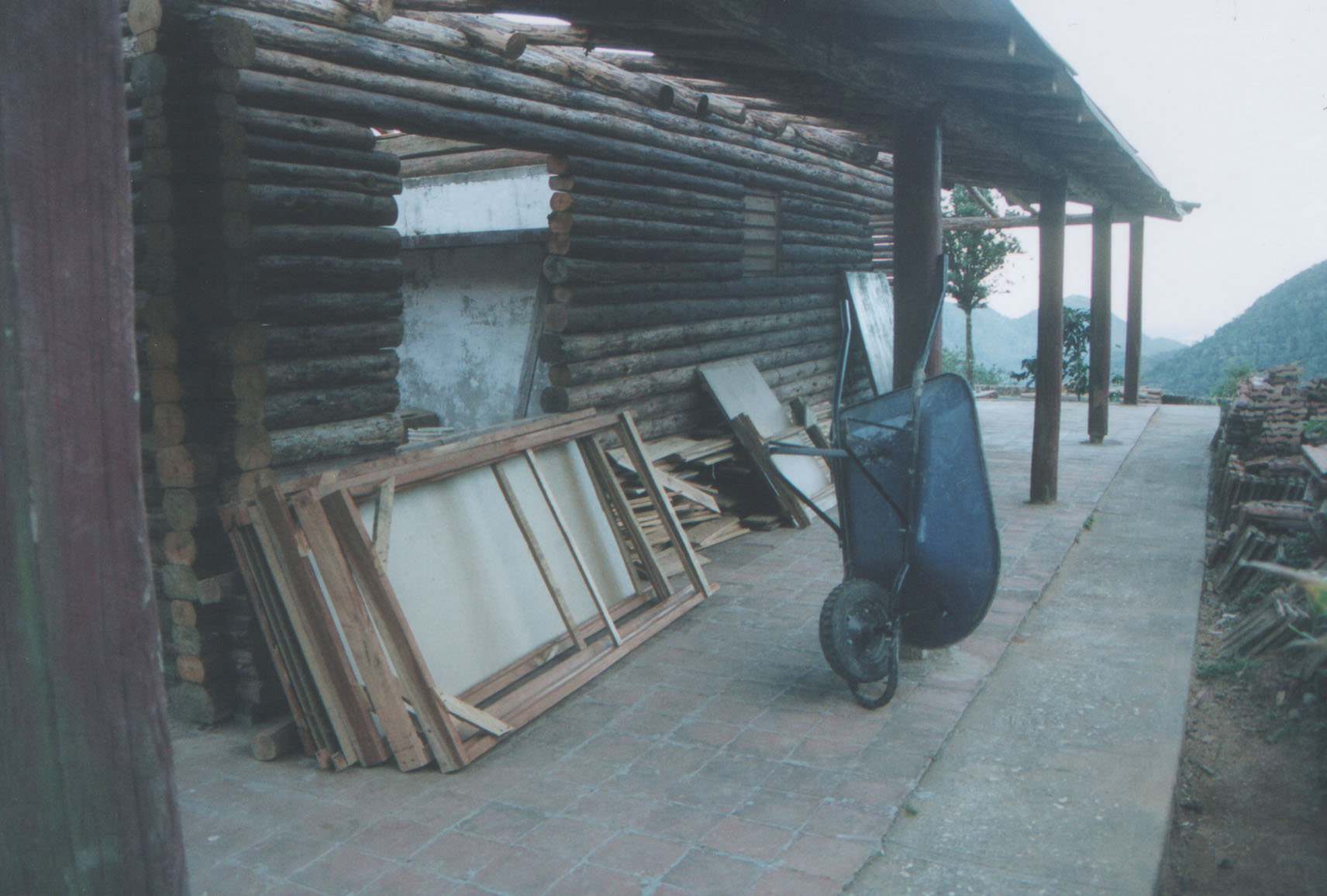
Under construction: the new Darwin Building at La Sabina, Alturas de Banao, starts to rise
|
|
Construction began immediately, and participants were able, on visits in late 2002 and early 2003, to enjoy the spectacle of an elegant new building (4 bedrooms, 2 bathrooms, one large common room and an extensive verandah) rising on the old site. Even before construction was complete, the site was used as the venue for a project workshop. Work was completed by April 2003, a splendid additional and unexpected output from the project, generating a lot of goodwill, and the building was put into use immediately, although a formal inauguration and addition of a small plaque recognizing the Darwin Initiative's key contribution, had to wait until November 2003.
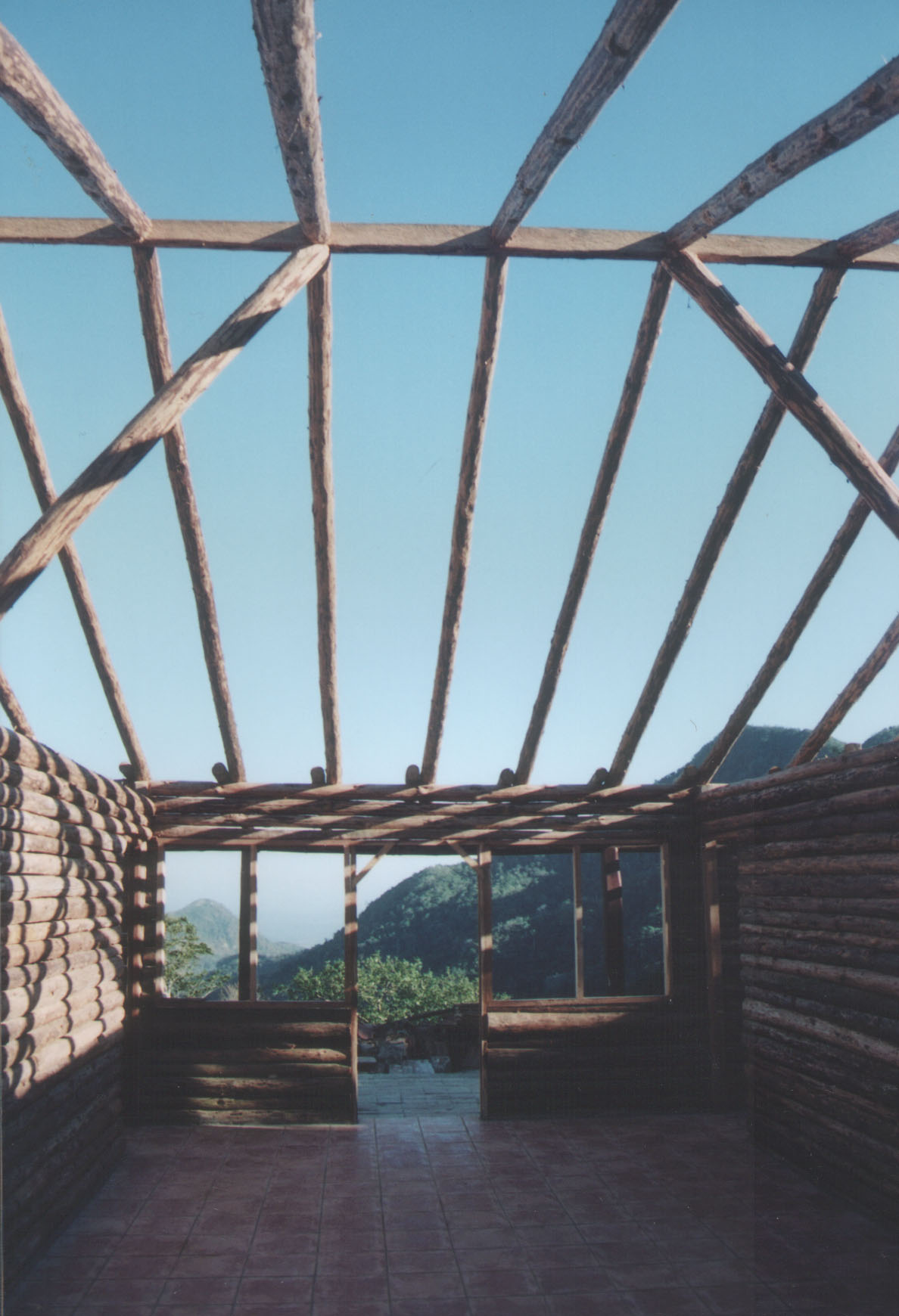
Roof beams in place: the new building nears completion
Completion opened the door to many other possible. The field station’s fresh-water supply and waste-water disposal, for example, were in a terrible condition, and were significantly up-graded with support from this project as it drew to a close.
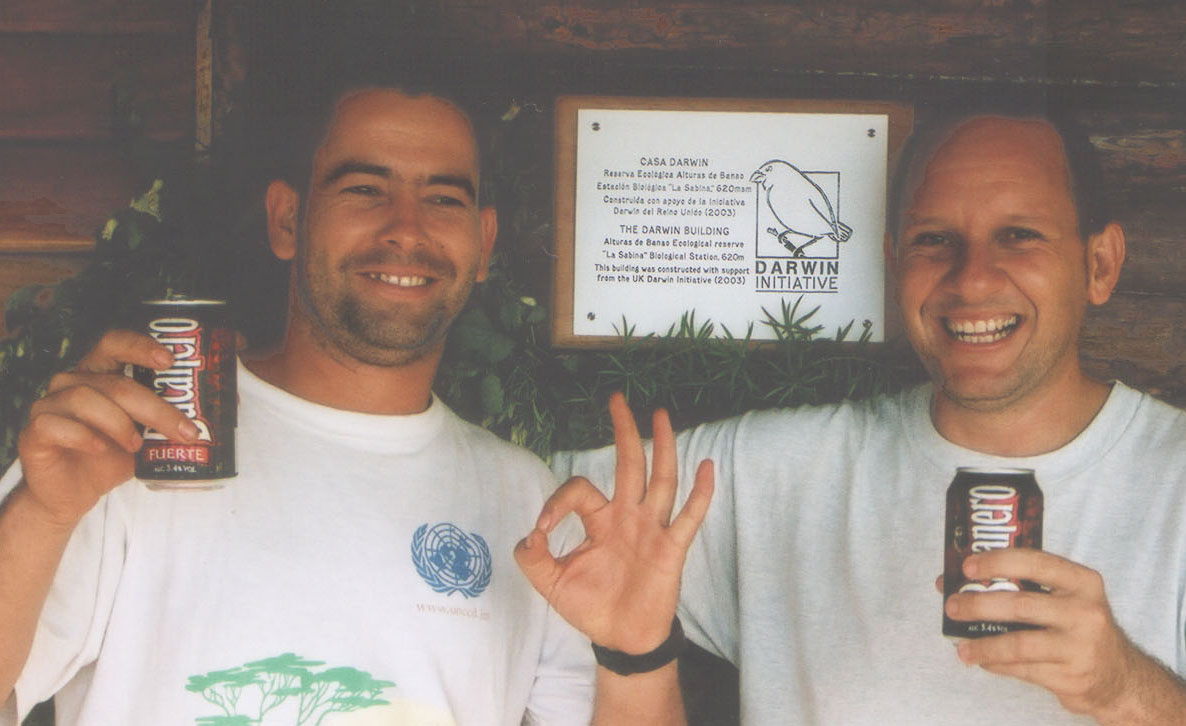
Maikel and Eldis celebrate inauguration of the new Darwin Building at La Sabina, Alturas de Banao
|
COMPUTERIZATION OF DATA ABOUT NEGLECTED GROUPS OF ORGANISMS
The present project provided an opportunity to continue the digitizing of data relating to observations of fungi begun in the earlier Darwin Initiative project Fungi of the Caribbean. This work continued very actively. Almost all of the keyboarded information is still in a queue for editing, so exact figures cannot be provided, but the number of records may exceed 100000. The following were the main components of this work.
|
Information in issues of the Bibliography of Systematic Mycology (bibliographic information about scientific publications relating to mycology) from its inception to the late 1970s was abstracted and keyboarded into a bibliographic database. This constitutes the bulk of the non-digitized backlog of this key catalogue. |
|
Records from a book on Venezuelan lichens were abstracted and keyboarded. This work filled a major gap in computerized information about Venezuelan fungi, opening the door to publication of a checklist for this enormous country. |
|
Literature missed during the previous project was traced and fungal records abstracted and keyboarded. |
|
All the records from Teng's monumental work on fungi of China were abstracted and keyboarded. Again this fills another major gap in computerized data. |
|
Work began to digitize information from the approximately 400000 records in the IMI reference collection (CABI Bioscience). There was no possibility to complete such a huge task within this project, but with a beginning made, it was felt that other funding might be forthcoming. |
Two other results came from this computerization work. Firstly, a small amount of project money was used to add a mechanical query facility to the key website Index Fungorum. Although this query facility is still at the experimental stage, it has been shown to work, and opens the door to critical future developments in providing information about scientific names of fungi. Secondly, a second draft of the checklist of Venezuelan fungi has now been produced, and there is hope to publish this work before the end of 2004.
PUBLICATIONS PRODUCED THROUGH THE PROJECT
The biggest single publication produced by this project's team was the website, Electronic Distribution Maps of Caribbean Fungi, in English and Spanish versions, with maps showing the distribution of more than 11750 fungi in the Caribbean. The same information was also published, again in English and Spanish versions, on CD. Most of this work was based on information abstracted and keyboarded during the previous Darwin Initiative project, Fungi of the Caribbean.
Another large website established through the project is the illustrated guide to plants of Viñales, providing photographs, keys and descriptions of more than 150 plant species, many of them rare endemics, to be found in that area of western Cuba.
The project also supported the production of single issues for two separate periodicals. The first was a special issue of Flora y Fauna (vol. 6 no. 1, 2002) featuring an article on fungi of the Caribbean. The second was a special issue of the Revista del Jardín Botánico Nacional (vol. 23 no. 2, 2002).
In addition the following (not an exhaustive list) publications were produced:
|
CAMINO VILLARÓ, M.C.; IGLESIAS BRITO, H.; MENA PORTALES, J.; MINTER, D.W.; RODRÍGUEZ HERNÁNDEZ, M. (2003). Electronic Distribution Maps of Caribbean Fungi. compact disk containing 11951 HTML-format pages & 11755 GIF-format maps. UK, Middlesex, Isleworth; PDMS Publishing. ISBN 0-9540169-4-7 |
|
CAMINO VILLARÓ, M.C.; IGLESIAS BRITO, H.; MENA PORTALES, J.; MINTER, D.W.; RODRÍGUEZ HERNÁNDEZ, M. (2003). Mapas Electrónicos de Distribución de Hongos del Caribe. compact disk containing 11951 HTML-format pages & 11755 GIF-format maps. UK, Middlesex, Isleworth; PDMS Publishing. ISBN 0-9540169-7-1 |
|
CASTAÑEDA RUÍZ, R.F.; ITURRIAGA, T.; MINTER, D.W.; SAIKAWA, M.; VIDAL, G.; VELÁZQUEZ-NOA, S. (2003). Microfungi from Venezuela. A new species of Brachydesmiella, a new combination, and new records. Mycotaxon 85: 211-229. |
|
CASTAÑEDA RUÍZ, R.F.; MINTER, D.W.; CAMINO VILARÓ, M.; SAIKAWA, M.; VELÁZQUEZ NOA, S.; DECOCK, C. (2003). Arachnospora insolita, a new genus and species, and some other hyphomycetes from Banao, Sancti Spíritus Province, Cuba. Mycotaxon 87: 385-393. |
|
CASTAÑEDA RUÍZ, R.F.; MINTER, D.W.; RODRÍGUEZ HERNÁNDEZ, M. (2001, publ. 2002). Digitoramispora caribensis. IMI Descriptions of Fungi and Bacteria. Set 149 No. 1483. 2 pp. |
|
CASTAÑEDA RUÍZ, R.F.; MINTER, D.W.; RODRÍGUEZ HERNÁNDEZ, M. (2001, publ. 2002). Kylindria obesispora. IMI Descriptions of Fungi and Bacteria. Set 149 No. 1485. 2 pp. |
|
CASTAÑEDA RUÍZ, R.F.; MINTER, D.W.; RODRÍGUEZ HERNÁNDEZ, M. (2001, publ. 2002). Myrothecium setiramosum. IMI Descriptions of Fungi and Bacteria. Set 149 No. 1487. 2 pp. |
|
CASTAÑEDA RUÍZ, R.F.; MINTER, D.W.; RODRÍGUEZ HERNÁNDEZ, M. (2001, publ. 2002). Paraceratocladium silvestre. IMI Descriptions of Fungi and Bacteria. Set 149 No. 1488. 2 pp. |
|
CASTAÑEDA RUÍZ, R.F.; MINTER, D.W.; RODRÍGUEZ HERNÁNDEZ, M. (2001, publ. 2002). Sporidesmium bifasciatum. IMI Descriptions of Fungi and Bacteria. Set 149 No. 1489. 2 pp. |
|
CASTAÑEDA RUÍZ, R.F.; MINTER, D.W.; RODRÍGUEZ HERNÁNDEZ, M. (2001, publ. 2002). Venustosynnema ciliatum. IMI Descriptions of Fungi and Bacteria. Set 149 No. 1490. 3 pp. |
|
DECOCK, C.; HERRERA FIGUEROA, S.; RYVARDEN, L. (2001). Studies in Perenniporia, Perenniporia contraria and its presumed taxonomic synonym Fomes subannosus. Mycologia 93 (1): 196-204. |
|
MERCADO SIERRA, Á.; CALDUCH, M.; GENÉ, J.; GUARRO, J.; DELGADO, G. (2003). Digitosporium, a new genus of hyphomycetes with cheiroid conidia. Mycologia 95 (5): 860-864. |
|
MERCADO SIERRA, Á.; DELGADO RODRÍGUEZ, G.; MENA PORTALES, J.; GUARRO, J. (2002). Some Hyphomycetes (Mitosporic Fungi) from “Ciénaga de Zapata” Biosphere Reserve, Cuba. Boletín de la Sociedad Micológica de Madrid 26: 183-188. |
|
MERCADO SIERRA, Á.; MENA PORTALES, J.; GUARRO, J.; HEREDIA ABARCA, G. (2002). Veracruzomyces, a new anamorphic genus from Mexico. Nova Hedwigia 75 (3-4): 533-537. |
|
MINTER, D.W. (2001). Fungal Conservation in Cuba. In D. Moore, M.M. Nauta, S.E. Evans & M. Rotheroe [eds] Fungal Conservation. Issues and Solutions. A special volume of the British Mycological Society. pp. 182-196. UK, Cambridge; Cambridge University Press. |
|
MINTER, D.W.; RODRÍGUEZ HERNÁNDEZ, M.; MENA PORTALES, J. (2001). Fungi of the Caribbean, An Annotated Checklist. 946 pp. UK, London, Isleworth; PDMS Publishing. |
|
PÉREZ, J.M.; RODRÍGUEZ HERNÁNDEZ, M.; MINTER, D.W. (2002). Sporisorium culmiperdum. IMI Descriptions of Fungi and Bacteria. Set 153 No. 1523. 2 pp. |
|
PÉREZ, J.M.; RODRÍGUEZ HERNÁNDEZ, M.; PIEPENBRING, M.; MINTER, D.W. (2002). Leucocintractia scleriae. IMI Descriptions of Fungi and Bacteria. Set 153 No. 1521. 2 pp. |
|
PÉREZ, J.M.; RODRÍGUEZ HERNÁNDEZ, M.; PIEPENBRING, M.; MINTER, D.W. (2002). Rhamphospora nymphaeae. IMI Descriptions of Fungi and Bacteria. Set 153 No. 1522. 2 pp. |
|
PÉREZ, J.M.; RODRÍGUEZ HERNÁNDEZ, M.; PIEPENBRING, M.; MINTER, D.W. (2002). Sporisorium everhartii. IMI Descriptions of Fungi and Bacteria. Set 153 No. 1524. 2 pp. |
|
PÉREZ, J.M.; RODRÍGUEZ HERNÁNDEZ, M.; PIEPENBRING, M.; MINTER, D.W. (2002). Sporisorium panici-leucophaei. IMI Descriptions of Fungi and Bacteria. Set 153 No. 1525. 2 pp. |
|
PÉREZ, J.M.; RODRÍGUEZ HERNÁNDEZ, M.; PIEPENBRING, M.; MINTER, D.W. (2002). Sporisorium paspali-notati. IMI Descriptions of Fungi and Bacteria. Set 153 No. 1526. 2 pp. |
|
PÉREZ, J.M.; RODRÍGUEZ HERNÁNDEZ, M.; PIEPENBRING, M.; MINTER, D.W. (2002). Sporisorium sorghi. IMI Descriptions of Fungi and Bacteria. Set 153 No. 1527. 3 pp. |
|
PÉREZ, J.M.; RODRÍGUEZ HERNÁNDEZ, M.; PIEPENBRING, M.; MINTER, D.W. (2002). Thecaphora amaranthi. IMI Descriptions of Fungi and Bacteria. Set 153 No. 1528. 2 pp. |
|
PÉREZ, J.M.; RODRÍGUEZ HERNÁNDEZ, M.; PIEPENBRING, M.; MINTER, D.W. (2002). Ustanciosporiium neomontagnei. IMI Descriptions of Fungi and Bacteria. Set 153 No. 1529. 2 pp. |
|
PÉREZ, J.M.; RODRÍGUEZ HERNÁNDEZ, M.; PIEPENBRING, M.; MINTER, D.W. (2002). Ustilago dieteliana. IMI Descriptions of Fungi and Bacteria. Set 153 No. 1530. 2 pp. |
|
RODRÍGUEZ, K.; FIGUERAS, M.-J.; GENÉ, J.; MERCADO SIERRA, Á.; GUARRO, J. (2001). Monodictys desquamata, a new mitosporic fungus from a Cuban rain forest. Nova Hedwigia 72: 201-207. |
|
RODRÍGUEZ HERNÁNDEZ, M.; MINTER, D.W. (2002). Los hongos en el Caribe. Flora y Fauna 6 (1): 45. |
|
RODRÍGUEZ HERNÁNDEZ, M.; MINTER, D.W.; CASTAÑEDA RUÍZ, R.F. (2001, publ. 2002). Ascopolyporus polychrous. IMI Descriptions of Fungi and Bacteria. Set 149 No. 1481. 2 pp. |
|
RODRÍGUEZ HERNÁNDEZ, M.; MINTER, D.W.; CASTAÑEDA RUÍZ, R.F. (2001, publ. 2002). Cerebella andropogonis. IMI Descriptions of Fungi and Bacteria. Set 149 No. 1482. 3 pp. |
|
RODRÍGUEZ HERNÁNDEZ, M.; MINTER, D.W.; CASTAÑEDA RUÍZ, R.F. (2001, publ. 2002). Eudarluca caricis. IMI Descriptions of Fungi and Bacteria. Set 149 No. 1484. 4 pp. |
|
RODRÍGUEZ HERNÁNDEZ, M.; MINTER, D.W.; CASTAÑEDA RUÍZ, R.F. (2001, publ. 2002). Leptoxyphium axillatum. IMI Descriptions of Fungi and Bacteria. Set 149 No. 1486. 3 pp. |
The following publications have also been prepared, but not yet published.
|
DECOCK, C.; HERRERA FIGUEROA, S. (submitted for publication). Poliporáceos nuevos o poco conocidos en Cuba. Cryptogamie Mycologie. |
|
DECOCK, C.; HERRERA FIGUEROA, S. (submitted for publication). The genus Navisporus. Mycologia. |
|
DELGADO RODRÍGUEZ, G.; MENA PORTALES, J. (submitted for publication). Virgariella ellipsospora sp.nov. (Hyphomycetes, Anamorphic Fungi) from Cuba. Cryptogamie Mycologie. |
|
DELGADO RODRÍGUEZ, G.; MENA PORTALES, J.; CALDUCH, M.; DECOCK, C. (submitted for publication). Hyphomycetes (Hongos Mitospóricos) del Área Protegida Mil Cumbres, Cuba Occidental. Crytogamie Mycologie |
|
DELGADO RODRÍGUEZ, G.; MENA PORTALES, J.; GENÉ, J.; GUARRO, J. (submitted for publication). A new species of Hughesinia (Anamorphic Fungi) from Alturas de Trinidad, Cuba. Mycologia. |
|
DELGADO RODRÍGUEZ, G.; MENA PORTALES, J.; GENÉ, J.; GUARRO, J. (submitted for publication). A new species of Cryptophialoidea (Hyphomycetes, Anamorphic Fungi) from Cuba. Mycologia. |
|
DELGADO RODRÍGUEZ, G.; MENA PORTALES, J.; MERCADO SIERRA, Á. (ready for submission). Nuevos registros he Hifomicetos (Hongos Anamórficos) en las Alturas de Trinidad (Cuba). Boletín de la Sociedad Micológica de Madrid. |
|
DELGADO RODRÍGUEZ, G.; MENA PORTALES, J.; MERCADO SIERRA, Á.; GUARRO, J. (submitted for publication). Hemicorynespora clavata sp.nov., a new Hyphomycete (Mitosporic fungi) from Cuba. Nova Hedwigia. |
|
HEREDIA ABARCA, G.; REYES ESTEBANEZ, M.; ARIAS MOTA, ROSA M.; MENA PORTALES, J.; MERCADO SIERRA, Á. (ready for submission). Adición al conocimiento de la diversidad de los Hyphomycetes del bosque mesófilo de montaña del estado de Veracruz. Revista Mexicana de Micología. |
|
HERRERA FIGUEROA, S.; ORTÍZ MEDINA, J.-L.; IGLESIAS BRITO, H.; DELGADO ROGRÍGUEZ, G.; GONZÁLEZ FRAGINALS, G. (not yet submitted). Hongos de las Reservas de la Biosfera de Cuba I: Listado de las especies reportadas en las Reservas Guanahacabibes y Sierra del Rosario. |
|
HERRERA FIGUEROA, S.; ORTÍZ MEDINA, J.-L.; IGLESIAS BRITO, H.; GONZÁLEZ FRAGINALS, G. (not yet submitted). Hongos de las Reservas de la Biosfera de Cuba II: Listado de las especies reportadas de las Reservas Cuchillas del Toa y Baconao. |
|
MENA PORTALES, J.; DELGADO RODRÍGUEZ, G.; CALDUCH, M.; GUARRO, J. (submitted for publication, and undergoing revision). A new species of Rhinotrichella (Hyphomycetes, Mitosporic fungi) from Cuba. Nova Hedwigia. |
|
MENA PORTALES, J.; DELGADO RODRÍGUEZ, G.; HERNÁNDEZ GUTIéRREZ, A.; GONZÁLEZ FRAGINALS, G.; MERCADO SIERRA, Á. (submitted for publication). Hifomicetos (Hongos Anamórficos) de Sierra de Cubitas, Cuba. Boletín de la Sociedad Micológica de Madrid. |
One further electronic publication is in preparation and nearing completion: a guide to insects on sugar cane. Publication on CD and as web-pages on the internet is anticipated by late 2005.



